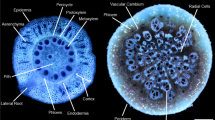Abstract.
The determinate growth of the primary root, its organization and relationship with lateral-root development, and the possible ecological significance of this growth pattern were analyzed in three sympatric species of Cactaceae from the Sonoran Desert, Stenocereus gummosus (Engelm.) Gibson & Horak, S. thurberi (Engelm.) Buxbaum and Ferocactus peninsulae (F.A.C. Weber) Britton & Rose, var. townsendianus (Britton & Rose) N.P. Taylor, stat. nov., Engelm. After seed germination, primary roots of these species commonly grew only for 2–3 d after the start of radicle protrusion (ASRP). This pattern of growth was observed on seedlings growing on filter paper, in vitro under sterile conditions, or in soil. The root-hair zone approached the very tip of the root and meristem exhaustion appeared to be typical in all seedlings of a population in all species. On average, 23 meristematic cells in the epidermal cell file in F. peninsulae were counted during the short steady-state period of growth (12–24 h ASRP). In S. gummosus, the size of the meristem was smaller with the number of epidermal cells in the meristem during the short steady-state growth period (12–36 h ASRP) averaging 13. The dynamics of meristem exhaustion obeyed Ivanov's model of the life span of cells in the meristem that states: if cell division is suppressed, half of the cells present in the meristem at a given time leave the meristem and start elongation during the period equal to the duration of the cell division cycle. It was deduced, on average, three to five cell division cycles in the meristem preceded its exhaustion. The lost meristem integrity can be related to only a few initial cells being found in the radicle. The cessation of meristematic activity in the primary-root apical meristem was directly related to the induction of lateral-root formation. Determinate primary-root growth can be thus viewed as a physiological root-tip decapitation that stops production of a signal inhibiting lateral-root primordia initiation. The time of lateral-root formation in S. gummosus and F. peninsulae was equal to or shorter than in agronomic mezophyte plants. Lateral roots also had determinate growth. The rapidity of root-system development and the ability to stop and to continue growth at any time under unfavorable and favorable conditions suggests the important role of determinate growth in seedling establishment of these Sonoran Desert species.
Similar content being viewed by others
Author information
Authors and Affiliations
Additional information
Received: 13 December 1996 / Accepted: 6 January 1997
Rights and permissions
About this article
Cite this article
Dubrovsky, J. Determinate primary-root growth in seedlings of Sonoran Desert Cactaceae; its organization, cellular basis, and ecological significance. Planta 203, 85–92 (1997). https://doi.org/10.1007/s00050168
Issue Date:
DOI: https://doi.org/10.1007/s00050168




